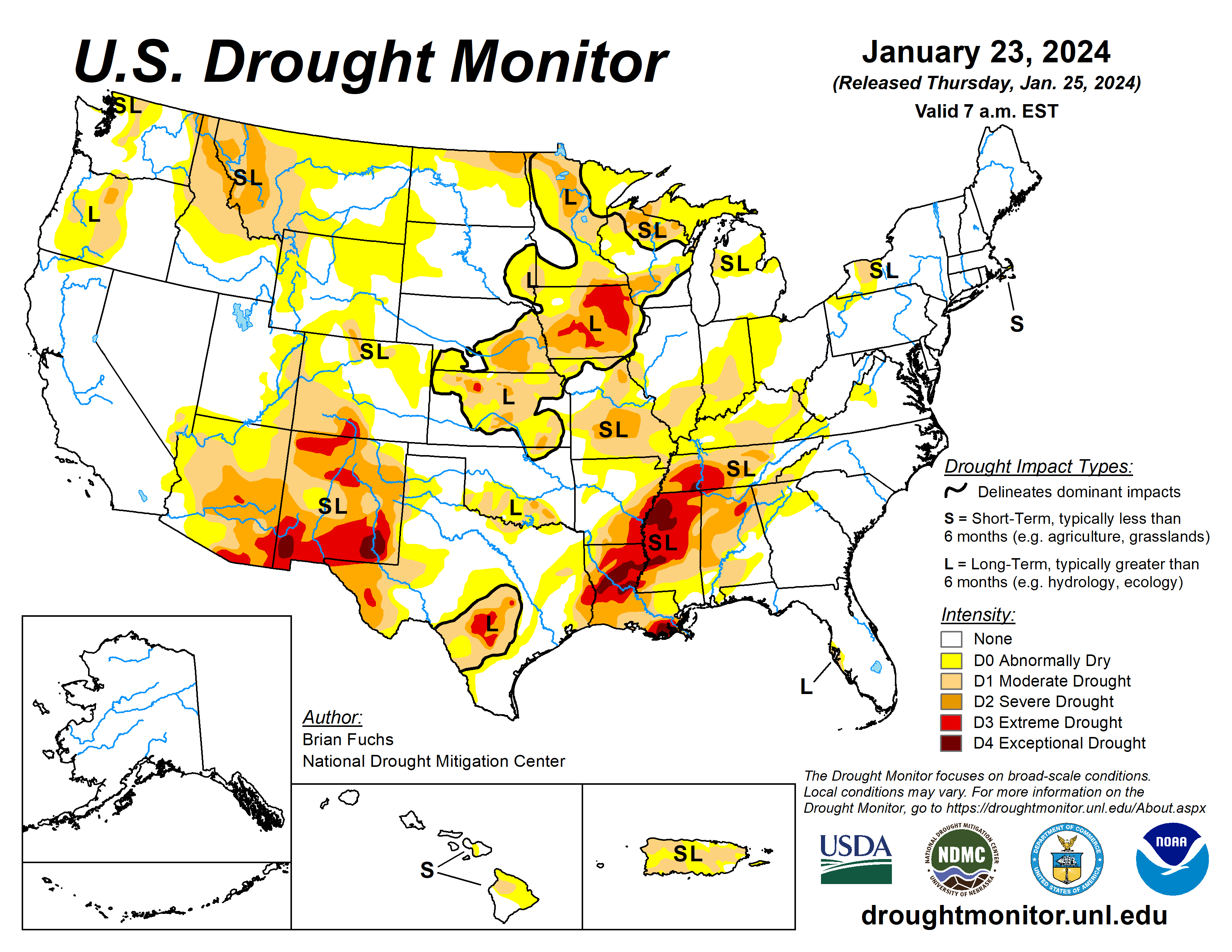Drier week but cold weather lingered longer

The current period was dry over most of the country with the greatest amount of precipitation occurring along the West Coast and from east Texas into Arkansas.
Temperatures were well below normal for most locations east of the Rocky Mountains, where departures were 5 degrees Fahrenheit or more below normal for most areas. The greatest departures from normal were over Tennessee, Kentucky, and northern portions of Alabama and Mississippi where readings were 20 to 25 degrees below normal.
The warm winter continued in the West with temperatures 5 to 10 degrees above normal over a majority of the region. The warmer-than-normal temperatures have been a challenge for snow accumulation with many locations, especially in the northern Rockies, having a very challenging start to the snow accumulation season.
With an active pattern through the central Plains into the Midwest the past few weeks, a reassessment of drought indicators was done in many locations this week to examine drought intensity levels and adjust where the data supported it. In most instances, drought remains but the data allowed for intensities to be reduced.
The end of the period had an active pattern again developing in the southern Plains and into the South where widespread precipitation was anticipated after the data cutoff for this week. These locations will be assessed on next week’s map.
The U.S. Drought Monitor is jointly produced by the National Drought Mitigation Center at the University of Nebraska-Lincoln, the U.S. Department of Agriculture and the National Oceanic Atmospheric Administration. (Map courtesy of NDMC.)
South
Cooler-than-normal conditions dominated the region with departures of 10-15 degrees below normal common in the region. The greatest rains took place in east Texas to southwest Arkansas and into southeast Oklahoma.
These rains continued past the data cutoff period and everything from Tuesday morning forward will be assessed on the next map. The rains allowed for some improvements, with a full category change over much of east Texas and improvements to moderate drought over central and northern Arkansas as well as the far northwest corner of Louisiana and southeast Oklahoma.
Midwest
Temperatures were below normal over the entire region this week with the greatest departures over Kentucky, where temperatures were 16 to 20 degrees below normal. There was some isolated precipitation over Missouri, southern Illinois, southern Iowa and northern Minnesota.
A reassessment of the data over western and southern Iowa allowed for some improvement to the extreme and severe drought in these areas. It was reported that insulation from the snow has kept soils thawed in some areas, and moisture infiltration is being observed in soils.
The last pocket of extreme drought was removed in southern Missouri along with improvements to severe drought here. Moderate drought was reduced in northwest and east central Missouri as the recent wetter pattern has allowed a shift in the physical indicators.
High Plains
It was a mostly dry week over much of the region with only eastern Kansas receiving widespread, albeit light, precipitation. Temperatures were below normal for all areas outside the plains of Colorado and Wyoming and northern North Dakota where they were 3 to 6 degrees above normal.
Outside of these areas, temperatures were generally 9 to15 degrees below normal for the week. The wetter pattern over the last several months allowed for a reassessment of the data to investigate potential changes in the drought intensity levels. It was noted that even though the last 9 to 12 months have a stronger signal toward the wet spectrum, there are still long-term issues that go out 24 to 36 months or more in much of the central Plains.
In looking at the data, support for the existing extreme drought in eastern Nebraska was not there, so it was improved to severe drought this week. In Kansas, areas of moderate and severe drought were also improved based on the lagging support for these intensity levels. Degradation took place over portions of northern North Dakota and eastern Wyoming where abnormally dry conditions were expanded based on the short-term dryness in these regions.
West
Above-normal temperatures dominated much of the region with departures of 9-12 degrees above normal over portions of western Wyoming. Temperatures were cooler than normal over much of Montana. The greatest rains were along the coast with some flooding issues being reported this week, especially in southern California.
Further inland, it remained dry and the dryness coupled with the warmer temperatures has allowed for snow drought to develop, especially in the northern Rocky Mountains. The wetter pattern over the most recent weeks allowed for a reassessment of conditions over New Mexico and into eastern Arizona, where improvements were made. Areas of extreme and exceptional drought were reduced this week in western New Mexico while severe drought was improved in western New Mexico into eastern Arizona. Moderate drought was expanded over western Wyoming and severe drought was expanded over western Montana.
Looking ahead
Over the next five to seven days, the active pattern over the South and Southeast will continue, with much of the region anticipating 3 to 5 inches of precipitation. The coastal areas of the Pacific Northwest also will remain active with the next system coming ashore. Dry conditions are expected over the central and northern Plains, northern Rocky Mountains and Southwest. Temperatures will flip back to a warmer-than-normal pattern for most of the country, with greatest departures above normal over the northern Plains and upper Midwest.
The 6–to 10-day outlooks show a high probability of warmer-than-normal temperatures over much of the U.S. during this period with the highest probabilities over the Plains and Upper Midwest. There are above-normal chances of above-normal precipitation over much of the West and into the Plains during this time.
Brian Fuchs is with National Drought Mitigation Center.



